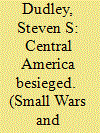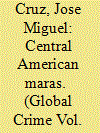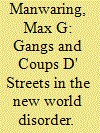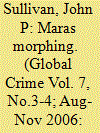|
|
|
Sort Order |
|
|
|
Items / Page
|
|
|
|
|
|
|
| Srl | Item |
| 1 |
ID:
108349


|
|
|
|
|
| Publication |
2011.
|
| Summary/Abstract |
The following is a threat assessment of the seven countries that make up Central America. That region is struggling to control burgeoning street gangs and organized criminal groups which have overrun its poor and ill-prepared security forces. The results are clear: rising crime and homicide rates throughout the region; corruption and instability within the governments. The two gangs that challenge authority are transnational in nature but pose less a threat to national security than they do to everyday life. Their drug peddling and extortion have shattered entire communities and forced the governments to reallocate important resources. The governments' strategy of jailing suspected gang members en masse has arguably made them stronger rather than weaker. Meanwhile, the organized criminal groups have deeply penetrated governments at nearly every level. They control swaths of territory, co-opting these areas, as well as the local governments, for their own purposes. Opposition to them is often futile. Mexican-based organizations are increasingly using violent tactics to displace their rivals. The governments of the region seem unprepared to meet the challenge.
|
|
|
|
|
|
|
|
|
|
|
|
|
|
|
|
| 2 |
ID:
099865


|
|
|
|
|
| Publication |
2010.
|
| Summary/Abstract |
Most of the empirical research on Central American street gangs, called maras, has been published only in Spanish. Reviewing that literature, the American scholarship on gangs, and my own research on Central American gangs from the mid-1990s, this article depicts the processes through which the maras (Mara Salvatrucha and the Eighteenth Street Gang) evolved from youth street gangs in the late 1980s to protection rackets with features of transnational organisations. Intense migratory flows between El Salvador, Guatemala, Honduras, and the United States, and the hard-line suppression policies against youth gangs in institutionally weak Central American countries created the conditions that prompted networking and organisation among Central American street gangs. This article highlights the changes in the dynamics of violence and the transformations in the gangs' social spaces to illustrate the evolution of the maras.
|
|
|
|
|
|
|
|
|
|
|
|
|
|
|
|
| 3 |
ID:
077342


|
|
|
|
|
| Publication |
2006.
|
| Summary/Abstract |
The mutation of protean "street gangs" to insurgents illustrates that insurgents need not be ideologically oriented, and need not be traditional revolutionary fighters emerging from the mountains and jungles to take down or control a government. Rather, they may have their own specific commercial money-making motives, and can emerge out of the favelas, callampas, villas miserias, and pueblas jovenes (city slums) not so much to replace governments as to gain very lucrative freedom of movement and action within a supposedly sovereign national-state. Also, mature second and third generation gangs have been known to act as proxies and mercenaries for traditional nation-states that want to maintain "plausible deniability," and to act as mercenaries for warlords, organized criminal organizations, and/or drug-trafficking cartels that - on certain occasions - need additional "fire-power". The instability and lack of individual and state security generated by gangs phenomenon and their nefarious allies are also known to lead to the radical change of failed state status. In these terms, gangs are no longer a singular law enforcement issue. As crime and war become more and more indistinguishable, gangs must be considered a larger national security issue - that, paradoxically, must be viewed as a local concept
|
|
|
|
|
|
|
|
|
|
|
|
|
|
|
|
| 4 |
ID:
077341


|
|
|
|
|
| Publication |
2006.
|
| Summary/Abstract |
Third generation street gangs are a crime and security problem in many global cities, internationally linked ethnic Diasporas, and cross-border regions where insecurity and criminal non-state actors reign. Widely known as third generation gangs (3 GEN Gangs), complex gangs operate with broad reach - often across borders - and can develop mercenary and at times political and potentially terrorist objectives. The typology of the three generations of gang evolution (based on the interaction of politicization, internationalization, and sophistication) is recounted, recent trends in transnational street and prison gangs are explored and future potentials are suggested.
|
|
|
|
|
|
|
|
|
|
|
|
|
|
|
|
|
|
|
|
|